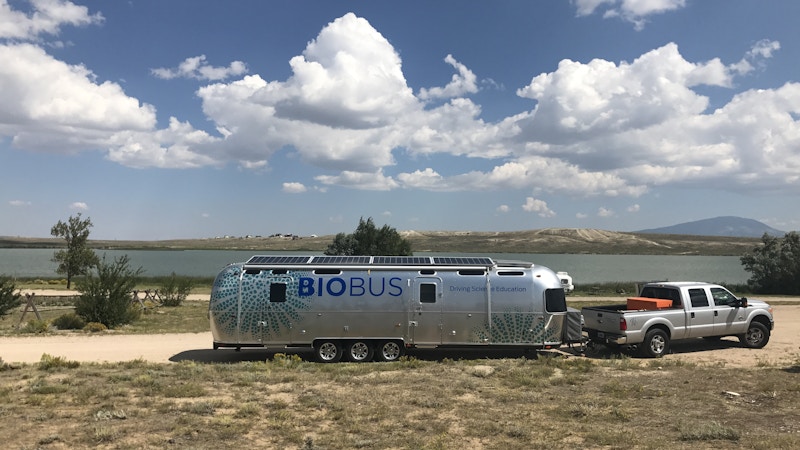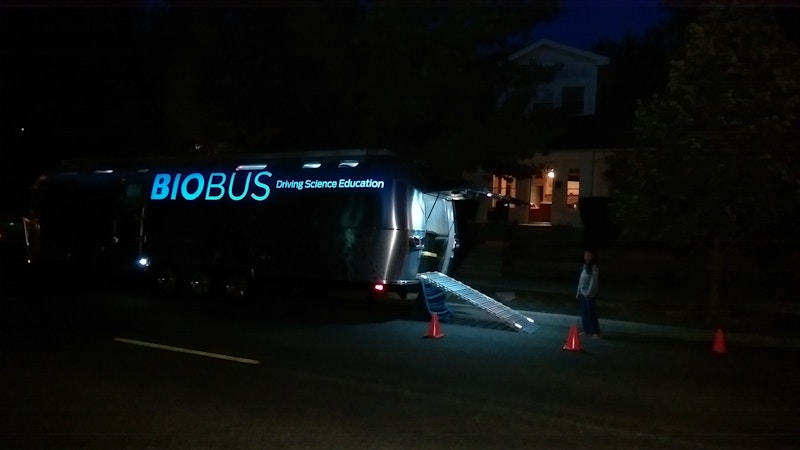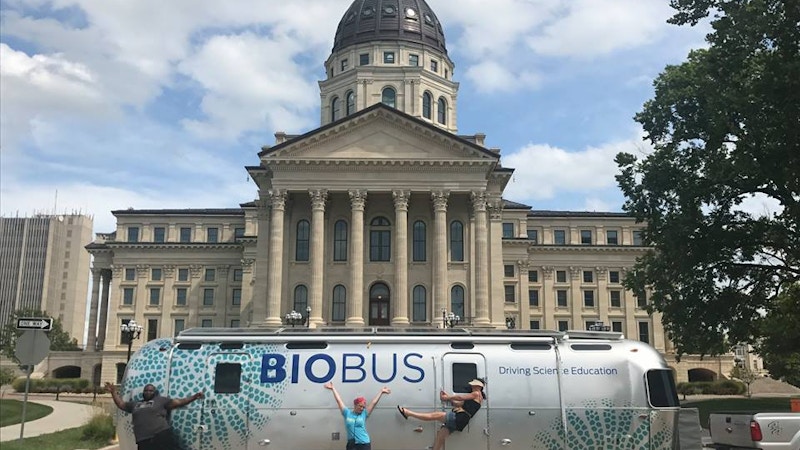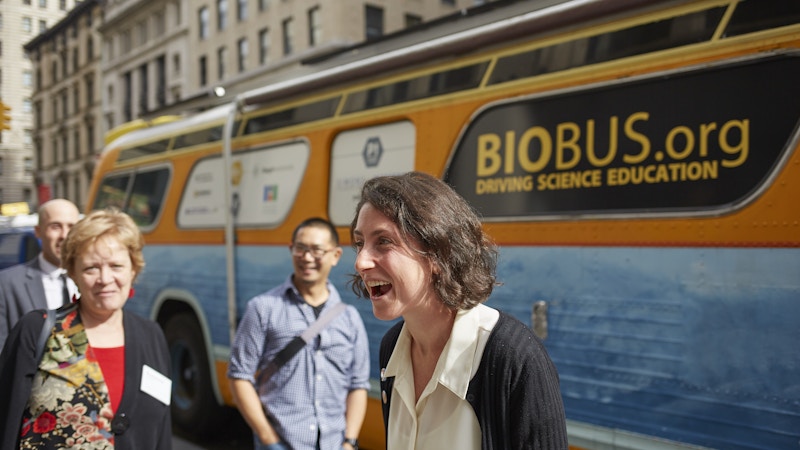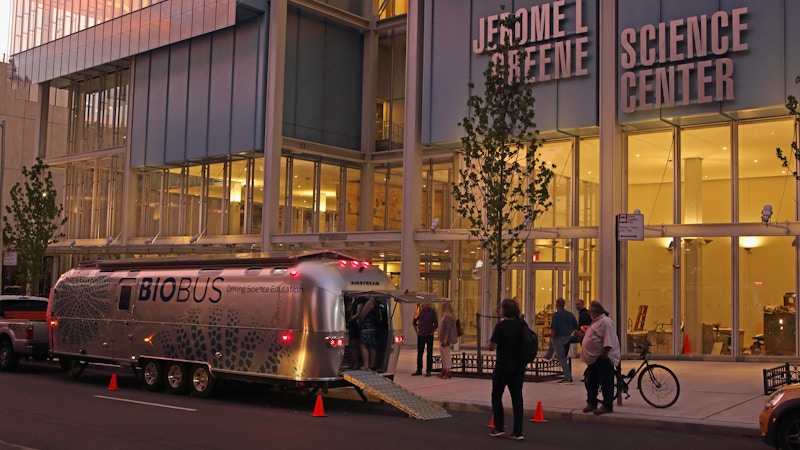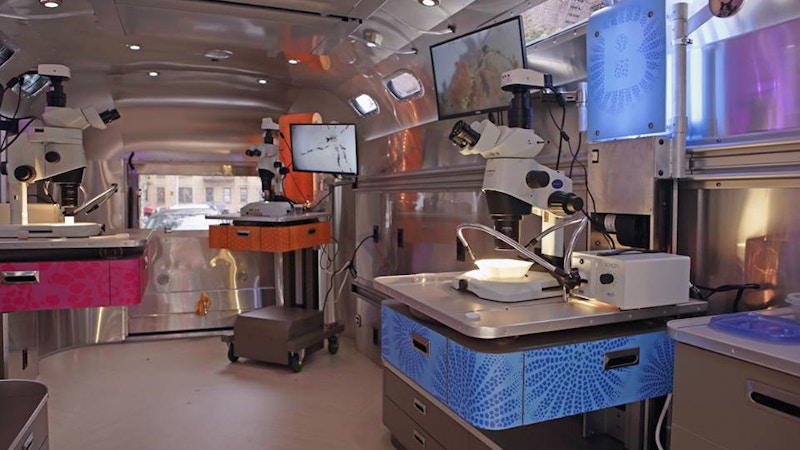
On the Road With a Brand-New BioBus
In the summer of 2017, just outside of Portland, Oregon, an employee of Ultimate Airstreams imparted an important driving lesson to a few New York City-based scientists: “There are no timelines in towing.”
“That phrase became our mantra for the trip,” explains Sarah Weisberg, chief scientist for BioBus and one of the nine BioBus staff members tasked with driving a brand-new mobile science lab from Oregon to the organization’s headquarters in New York City. “I had a family bar mitzvah coming up that I was supposed to be back for, and I wasn’t sure if I was going to make it.” When her family asked why, all she could say was, “Listen, there are no timelines in towing.”
Weisberg eventually made it home. So did BioBus 2, a state-of-the-art Airstream trailer (though the staff still refers to it as a bus) fitted with thousands of dollars’ worth of research-grade microscopes. It’s the second mobile lab in what BioBus hopes will become a small fleet. Since 2008, BioBus has been driving its original mobile lab — an old, retrofitted city transit bus — to Title I schools across New York City. Groups of K-12 students spend 45-minute periods on the bus, experiencing hands-on lab sessions conducted by BioBus scientists (staff members plus some volunteers). To date, BioBus has served more than 200,000 students at over 500 schools in the New York region. In 2014, the organization received funding from the Simons Foundation to build Bus 2, enabling BioBus to double its yearly reach. It also built a Bio ‘Base’ at Columbia University’s Zuckerman Institute in Harlem. As with the first BioBase, housed in the Lower Eastside Girls Club, the Harlem BioBase features science programming and internship opportunities for high school and college students.
When BioBus 2 was completed, around August 2017, Weisberg and other staff members made the trip to the Ultimate Airstreams headquarters in Wilsonville, Oregon, to drive it 3,500 miles back. Once on the road, they quickly experienced the realities of “no timelines in towing,” and it became difficult to coordinate pickups for BioBus staff members arriving in various cities to help drive the bus home. Several flight times and even destination cities had to change.
They also got a crash course on the benefits of four-wheel drive. Weisberg wanted the road-trip staff to make a stop to view the 2017 solar eclipse, so she secured a rental space on a farm that was in the path of totality in rural Missouri. When they got there, the trailer had difficulty sustaining traction on the farm’s muddy hillside. The hosts, Weisberg recalls, “just looked at us like we were such obvious Yankees,” adding that none of the staff had experience driving in the countryside. “I’ve never really felt more like a city dweller than I did in that moment.”
By clicking to watch this video, you agree to our privacy policy.
But once they — literally — gained control of the situation, they were able to watch the eclipse by a river that ran through the property. And they managed to avoid close calls for the rest of the trip, Weisberg says.
What they couldn’t avoid, though, was attention. “We had to give ourselves time to stop for gas,” explains Ray Wilkerson, one of two professional drivers on the BioBus staff. “Stopping for gas meant ‘meet and greets.’” The team met a group of geologists in Kansas, gave tours at a bed-and-breakfast in western Pennsylvania, and engaged countless curious kids across the country.
“It was just so great to see how many people, in different communities, would immediately come together,” Wilkerson recalls. “The bus just spills love. A lot of love.”
And everyone seemed to appreciate their story. “Given how divisive a lot of rhetoric is in this country right now,” Weisberg says, “to be traveling from Oregon to New York with something that says ‘science education’ on it, and to get nothing but generosity and curiosity — that was really amazing to me.”
The response during their road trip was a good omen for their first school visit with BioBus 2 at the Washington Heights Expeditionary Learning School (known as WHEELS). There, they met an old friend, a teacher named Jared Fox, who is a BioBus board member. Fox was the first teacher to bring the original BioBus to a New York City school. “It was really a celebration of this achievement,” Weisberg says of the full-circle moment.
Doubling their bandwidth is only the beginning of BioBus’s next phase. “In every part of the design for the new bus, we had scalability and reproducibility in mind,” Weisberg says. Moreover, because the design for the new BioBus is highly modular, enabling scalability in size and flexibility in production cost, the BioBus team hopes to create a pathway for people and organizations across the country, and even the world, to build their own mobile labs.
The BioBus staffers certainly have their share of fans. During the road trip, while searching for a place to park the Airstream near the Denver airport, they called a parking lot and were offered a rate of $6.50 — even though they were towing a 34-foot-long trailer. When they arrived at the parking space, they realized that the turn into the lot was too sharp to make. “So the guys were like, ‘Don’t worry, we’ve got a special spot for you around back,’” Weisberg recalls. “They gave us this VIP treatment. And in the end, when we went to pay, they didn’t even charge us.”
Why? “Because the bus is love,” Weisberg says. A new mantra for the road ahead, perhaps.
BioBus staff engage in some trailer parking practice in Idaho. Credit: BioBus
